BY STEVEN CROOK
Pingtung County’s Donggang Township will be the scene of the King Boat Festival, held every three years, from October 4 to 11 this autumn.(This article is wriiten in 2015, this year, 2018, The festival starts from October 28 to Novenber 4.)
For most of its history, Taiwan was a thoroughly pestilential place. In the 1700s, it was said that of every 10 Chinese migrants who reached the island, “Just three remain. Six are dead, and one has returned home” (三在六亡一回頭). Not until well into the Japanese colonial era was plague brought under control. In the late 1940s, cholera, scrub typhus, and bilharzia (a disease caused by parasitic worms) were still major health threats. Victory over malaria was finally declared in 1965.
Given the virulence of these ailments and the scientific ignorance of the island’s early settlers, it is hardly surprising that epidemics were blamed on malevolent spirits. Then as now, Taiwanese beseeched their gods for protection. Many people wore sachets of incense ash gathered from temples, similar to the amulets that now dangle from rearview mirrors in cars and trucks across Taiwan.
These notions and habits were carried to Taiwan by migrants from the China mainland. As Carol Ann Benedict explains in her book Bubonic Plague in Nineteenth-century China (Stanford University Press, 1996), in southern China plague-god festivals “were periodically held in many communities as prophylactic measures against epidemics; similar rituals were held after an epidemic had broken out. Lasting about a week, the jiao (醮, sacrificial rites) included days of elaborate temple rites and liturgies, culminating in a large processional designed to expel all remaining plague demons and send the plague god back to heaven. This was done by placing the wenshen (瘟神, “epidemic gods”) on massive boats (wenchuan, 瘟船, “plague boats”) made of paper or grass that were then burnt or floated away.”
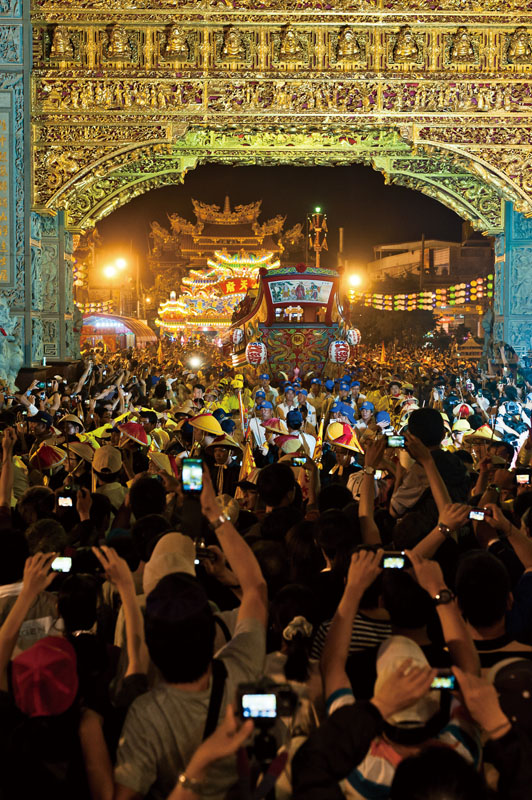
Some scholars think the discovery that fire is effective at destroying pathogens may be one inspiration for this custom, which could be 1,000 years old.
Within Taiwan, the term wangchuan (王船) is preferred to wenchuan. Two major ritual boat-burnings are celebrated each Year of the Goat, Year of the Dog, Year of the Ox, and Year of the Dragon – timing inspired by the triennial inspection tours made by mandarins in ancient China. The best known of these is the King Boat Festival (迎王平安祭) organized by Donglong Temple (東隆宮) in Pingtung County’s Donggang Township. As 2015 is the Year of the Goat, the King Boat Festival will run this year from October 4 to 11.
The other major ritual boat-burning ceremony is sometimes called Taiwan’s Foremost Offering of Incense (台灣第一香), and is centered on Qingan Temple (慶安宮) in Tainan City’s Xigang District. The 2015 edition was held May 28 to June 1.
Xigang is a nondescript town with a population of just 25,000. However, its wangchuan rites – first held in 1784 and now involving 96 villages – are said to be more faithful to tradition than the one in Donggang. The climatic stages have barely changed since David K. Jordan, now professor emeritus in University of California San Diego’s Department of Anthropology, did research in the area in the late 1960s.
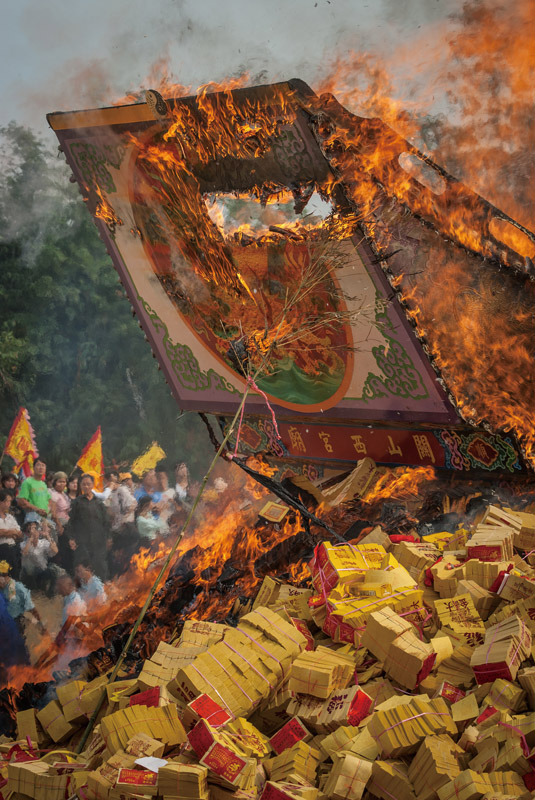
In a paper published in 1976 in Asian Folklore Studies, Jordan described how malicious spirits are entrapped during the ritual: “Late in the evening of the third day, the priests file into the temple, where the demons of disease are at rest. Quickly the demons are captured by spells and chants and confined to a paper-and-wood ship, so that they are no longer free to roam the countryside working disaster on its inhabitants. On the following morning the ship, an elaborately decorated object some 20 feet or so in length is hauled to the middle of a field [and] ceremonially burnt and thus destroyed, demons and all.”
Yet wangchuan customs are not immutable. In November 2013, Chenwei Temple (宸威殿) in Penghu County held its first boat immolation in 26 years. During previous burnings, live chickens, pigs, and goats were sacrificed in the blaze. No doubt conscious of the outcry that would ensue from animal-rights groups, this time the animals were loaded aboard, then released before the vessel and its other contents were hosed down with gasoline and set afire. During the same rites – which reportedly cost over NT$10 million to produce – other non-traditional elements included scantily clad pole dancers and a palanquin equipped not only with loudspeakers and LEDs but also pyrotechnic spark-throwers.
The alternative to burning mentioned by Benedict – constructing a seaworthy boat that is then pushed out to sea – is now seldom practiced in Taiwan, yet it previously helped shape the island’s religious landscape. Ocean currents carried a good number of wenchuan from Fujian to Taiwan’s southwest. Realizing these vessels were plague boats, the communities receiving them reacted with a mixture of fear and awe, and dared not ignore them. Icons that reached Taiwan in this way are revered in dozens of houses of worship, notably Nankunshen Daitian Temple (南鯤鯓代天府) in Tainan City’s Beimen District.
Honoring the demons
The key characters in boat burnings and launchings are known as Wang Ye. According to Keith Stevens, an academic specialist in Chinese religion, these supernatural personalities fall into two categories. The first comprises “those whom [Fujianese and Taiwanese] know to be disease spirits or fiends but, by using the polite honorific Wang Ye, they not only avoid voicing the spirits’ or demons’ true identity and offending them, but also… honor them, with the consequential hope of buying them off.” The second category “consists of a number of individual deified folk heroes, bona fide deities from the higher echelons of the pantheon.”
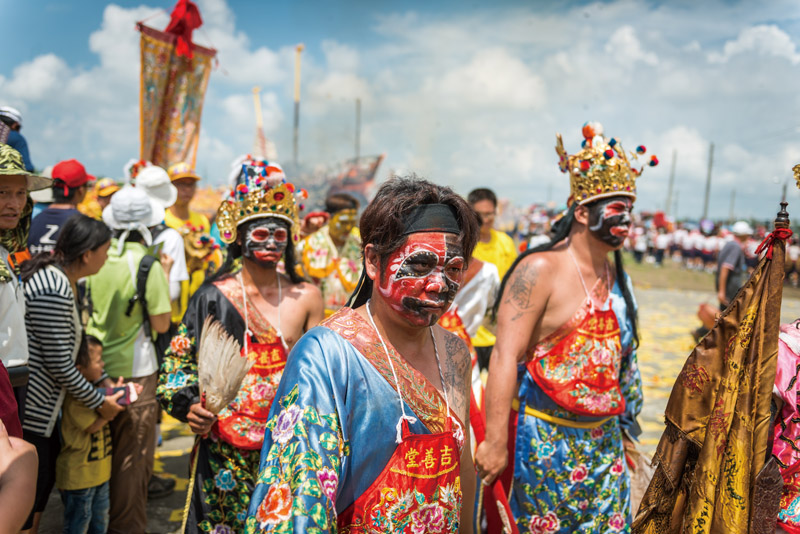
The words wang ye (王爺) mean “royal lord,” but this name is more honorific than accurate. The only royal connection is that legend holds the original spirits were 360 musicians and scholars employed by Emperor Taizong (reigned 626-649), 36 of the same emperor’s officials who died in a shipwreck, or perhaps five scholars who drowned themselves in a well so villagers would not drink water poisoned by a ghoul.
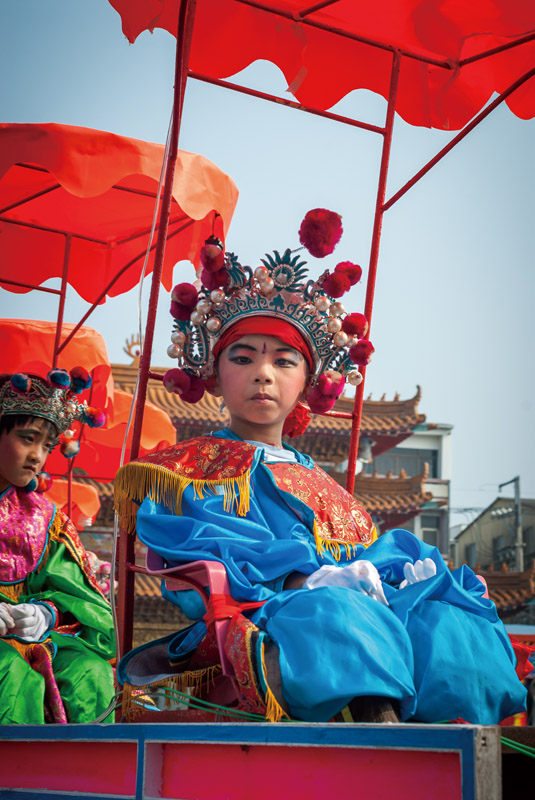
Taiwanese are now well-educated and enjoy good healthcare, yet wangchuan ceremonies are as popular as ever. In part this fact reflects growing pride in local culture, and local governments’ eagerness to promote local festivals. The King Boat Festival has received financial support from the Pingtung County government since 1994. Like the Xigang event, the rites in Donggang are an excellent opportunity to see a range of zhentou troupes give performances that go beyond the usual stilt walking, lion dancing, and martial arts.
Modern boat-burning rituals are less specifically concerned with disease-spreading phantasms than with general good fortune. According to Paul R. Katz, a research fellow in Academia Sinica’s Institute of Modern History, Wang Ye are now regarded as “protective spirits capable of preventing all manner of calamities.”
Donggang’s relationship with the sea is obvious. Dozens of fishing vessels are moored less than 100 meters from Donglong Temple, where the principal deity is Marshal Wen (溫鴻), also known as Wen, Lord of A Thousand Years (溫府千歲). Some believe this Wang Ye was one of the 36 shipwrecked officials deified by Emperor Taizong.
Jenna Cody, a Taipei-based corporate trainer who attended the 2009 and 2012 King Boat Festivals, urges those who can to attend the very first day of the festival as well as its fiery conclusion. “The first and final days are both fascinating, but in different ways. On the first day, spirit mediums go to the beach to call Marshal Wen. Anybody called by the gods – male or female, associated with a temple or not, trained or not – can become a medium, and be one of hundreds who are possessed. Elsewhere in Taiwan, female spirit mediums are rare, and the ones you see rarely cut or beat themselves the way those in Donggang often do,” says the Poughkeepsie, New York native.
Cody advises anyone attending the beach ceremony to bring water and sunscreen. “Also, wear quick-dry pants – you’ll probably find yourself in the water.”
At the same time, Taoist priests invite a horde of Wang Ye to Donggang. Divination rites conducted the day before by representatives of the town’s seven religious associations or jiaotou (七角頭) ascertain the name of the spirits’ leader, but it is not until the gathering on the beach that the name can be attached to one of the deities present.
In 2012, the chief was Lord Geng (耿). His name was painted on the prow of the King’s Ship and onto a lantern dangling from the vessel’s main mast.
At the Donggang event, pious bystanders holding incense sticks are hugely outnumbered by those clutching cameras or smartphones. “There’s no sense of ‘these are sacred and private rites, and you should leave us in peace.’ The crowd is very much part of the spectacle, and is expected, accepted, and welcomed,” says Cody. “The tradition runs deep and is cultural as well as religious. It really takes over the town.”
Each King Boat is a work of art created by volunteer craftsmen and completed well in advance; delicate paintings of dragons, elephants, and sages adorn the hull. The 2012 vessel, which cost a reported NT$7 million to build, was 13.82 meters long. The dimensions, which are decided by means of divination, vary slightly from one festival to the next.
“For NT$100, anybody can buy a wooden plaque and write a wish on it which is later loaded onto and burned with the boat,” says Cody. “In 2012 my wish was for Taiwan independence. I’m not joking! It’s totally okay to add your wish, even if you’re not a believer. This is done while the boat is still in its shed in front of the temple. It’s traditional to walk around the boat three times before tying your plaque to the fence around it.
Living folklore
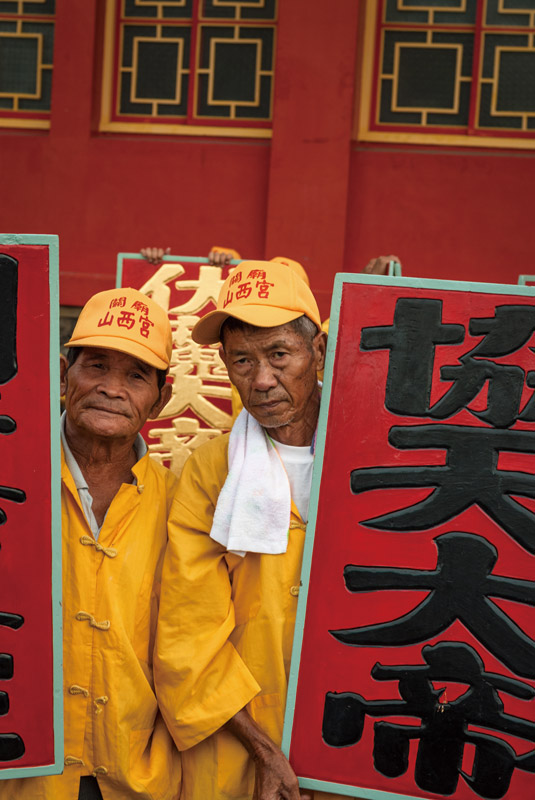
The timing of the actual burning is far from convenient for those who travel from afar, but makes for unforgettable images. Unlike Xigang, where the boat is set alight in the early afternoon and reduced to an immense heap of smoldering ash by dusk, the Donggang inferno lights up the night sky.
Enthusiasts who arrive early on the final day can follow the boat as it is dragged through the town, drawing evil influences aboard. The vessel then returns to Donglong Temple where rites dominate evil spirits with the help of hot oil, firecrackers, and whips – and thank beneficial ones through chanting, drumming, and pipe music.
After dark, the loading begins of things chosen to amuse and distract the supernatural entities who were hoodwinked into boarding the ship. Among them are pipes for smoking, dice for gambling, plus woks, spoons, and condiments for cooking. Every item is traditional. The pails are wooden, not plastic; earthenware pots hold drinking water; the writing materials are inkstones and calligraphy brushes. The boat is equipped with a miniature cannon and a lifeboat that is hardly big enough for a six-year-old, but the dimensions make sense considering the effigies that crew the King Ship are barely 40 centimeters tall.
Each task is assigned to one of the jiaotou. The names of these groups reflect the place names used during the Japanese colonial era, rather than modern ones. Membership is overwhelmingly male, but includes a good many people under the age of 40.
Distinguishing one jiaotou from another is easy; each wears a certain color associated with one of Donglong Temple’s deities. Blue outfits mean the crew has been assigned to Marshal Wen, and are responsible for his palanquin. The yellow team takes care of the hull, while the black, green, pink, purple, and white crews are assigned other duties.
Because different jiaotou interpret certain rules and traditions in different ways, Cody on one occasion was allowed to participate in the traditional firewalking in front of Donglong Temple on the first evening of the festival, but was not permitted to do so three years later. “Also, certain jiaotou don’t let women handle the paper money and offerings which are to be loaded onto the boat,” she notes.
The boat is not moved to the beach until around 2 a.m. When the signal is given, the crowd follows at a rapid clip, as everyone wants to snag a good vantage point. For the better part of a mile, visitors jostle with one another and the deity-bearing palanquins, as well as with the jiaotou teams carrying masts or anchors.
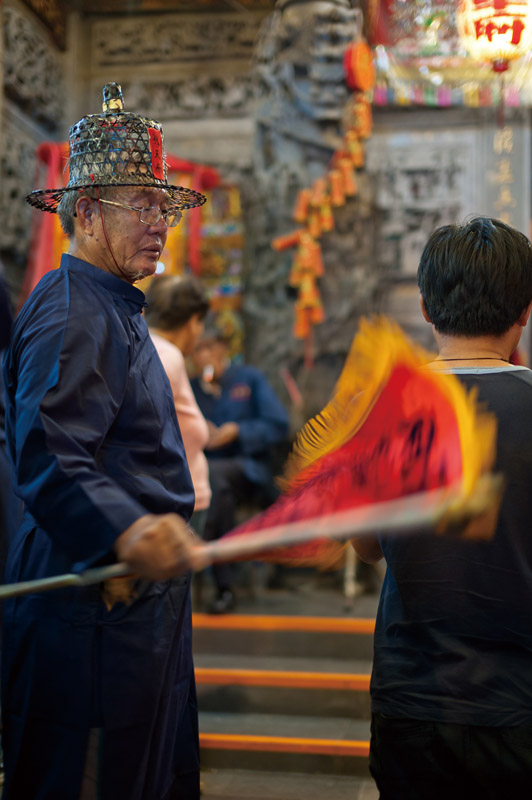
At the beach, jiaotou personnel raise the masts, unfurl the sails, and lay bales of ‘spirit money’ (yellow paper rectangles made for burning during folk rites) around the vessel. Firecrackers serve as detonators for the pyre. While this is being done, Taoist clerics round up errant spirits. After 5 a.m., the vessel is finally consigned to another dimension.
Smoky explosions soon give way to sheets of flame. Within just a few minutes, the ship is being devoured. Flying embers burn holes through the sails. The 36 figurines on the main deck shed limbs, then topple over. By the time the sky begins to lighten, the hull is blackened and broken. Confident that misfortune has been dispelled and prosperity assured for another three years, many locals leave soon after the fire takes hold. By the time is sun is properly up, the crowd has thinned, making it possible to get as close as the intense heat allows, and to watch the final stages of destruction. Of all the remarkable sights offered up by Taiwanese folk religion, this scene is possibly the most extraordinary.
This article was originally published by Taiwan Business TOPICS


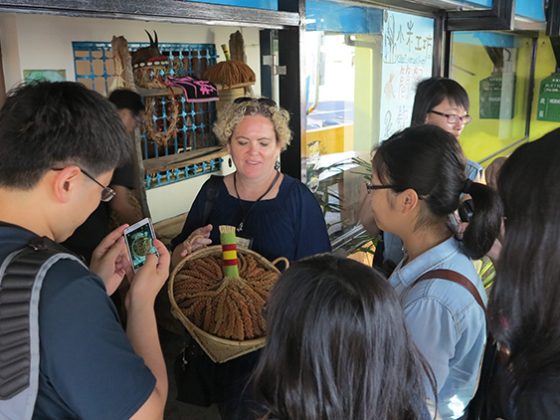










Comments are closed.